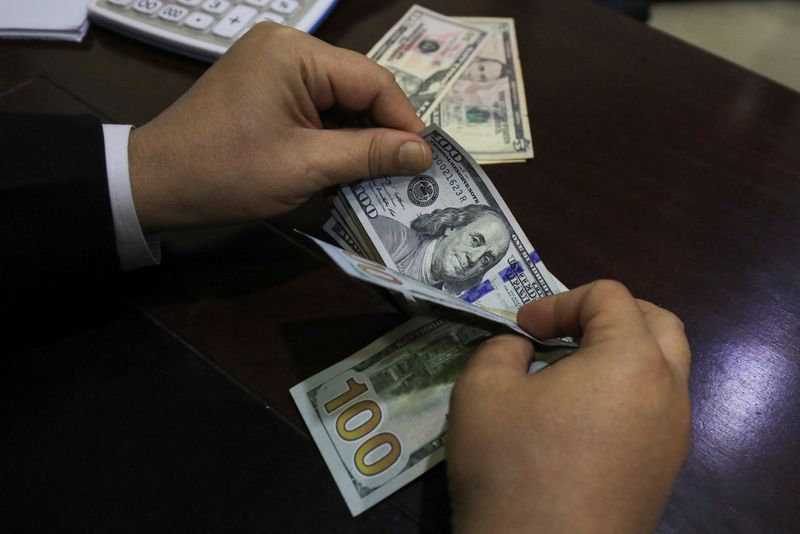By Gertrude Chavez-Dreyfuss
NEW YORK (Reuters) -The dollar strengthened on Tuesday after U.S. economic data showing a broadly stable jobs market and a still-robust services sector suggested the Federal Reserve is likely to slow the pace of its current rate-cutting cycle.
The dollar rose to an almost six-month high against the yen after the US data. It was last up 0.2% at 157.875 yen. Earlier in the global session, the dollar hit its highest since July at 158,425 yen.
Data showed that U.S. job openings unexpectedly increased in November, although hiring declined over the month. Job openings, a measure of labor demand, rose by 259,000 to 8.098 million on the last day of November, according to the Bureau of Labor Statistics’ Job Openings and Labor Turnover Survey (JOLTS report). However, the workforce fell by 125,000 to 5.269 million in November.
Activity in the US services sector also accelerated in December, while a rise in a measure of prices paid for inputs to the highest level in almost two years pointed to high inflation. The Institute for Supply Management’s purchasing managers’ index (PMI) rose last month to 54.1 from 52.1 in November.
“The really big surprise in the report was the jump in the Prices Paid Index from 58.2 to an 11-month high of 64.4 in December – perhaps reflecting higher transportation costs or delivery costs during the holidays,” wrote Dave Rosenberg, founder and president of Rosenberg Research, in a note to clients.
“Suffice it to say that the (ISM) report was enough to prompt markets to now expect just over one Fed rate cut for the year, which has now been pushed back to July from June.”
Based on the data, the US interest rate futures market has priced in a 95% chance of a pause in rate cuts this month, and a 4.8% chance of an easing, according to LSEG estimates. Rate futures also implied only 37 basis points of cuts in 2025, compared to two cuts expected from the Fed’s dot plot, or rate forecasts.
Investors are also assessing whether newly-elected President Donald Trump’s actual tariff policies will match his tough rhetoric.
Market participants have priced in a scenario in which the introduction of widespread tariffs could boost U.S. inflation, potentially limiting the Fed’s ability to cut rates and thus supporting the dollar.
But they wondered whether officials are preparing to water down some of Trump’s campaign promises. Trump on Monday denied a Washington Post report that said his aides were exploring tariff plans that would cover only crucial imports.
However, Karl Schamotta, chief market strategist at Corpay in Toronto, thinks the market is betting that Trump “will ultimately implement a more limited package of tariffs on key trading partners, and lower U.S. inflation and interest rate expectations in line.”
In afternoon trading, the , which measures the currency against six major units, rose 0.2% to 108.55 after falling overnight to 107.74, its weakest level since December 30.
On Jan. 2, the index hit a more than two-year high of 109.58, reflecting expectations that Trump’s promised fiscal stimulus, reduced regulation and higher tariffs would boost U.S. growth.
The euro, on the other hand, fell 0.4% to $1.0352, continuing its decline following the economic data. The currency rose earlier after Eurostat data on Tuesday showed inflation in the 20 countries that share the euro rose to 2.4% last month from 2.2% in November.
Meanwhile, eurozone households raised their inflation expectations in November, an ECB poll showed. Inflation in the twenty eurozone countries rose last month from 2.2% in November to 2.4%, Eurostat said on Tuesday.
Investors are also looking ahead to Friday’s US non-farm payrolls report. A Reuters poll showed 160,000 jobs would be added in December, up from 227,000 new jobs created in November.
“The health of the U.S. labor market is critical to expectations for the Federal Reserve’s actions this year, so it’s likely that barring any big news about the incoming administration, we could see calmer currency waters through Friday morning,” says Helen Given, currency trader. , at Monex USA in Washington.
In cryptocurrencies, bitcoin tumbled more than 5% to $96,322.43, after previously hitting a three-week high.
Currency
bid
prices at
7
January
07:57
pm GMT
Description RIC Last US Pct YTD Pct High Low
at Close Change bid
Last
Session
Dollar 108.54 108.31 0.22% 0.05% 108.59 107.
index 84
Euro/pop 1.0354 1.0391 -0.34% 0.02% $1.0434 $1.0
ar 349
Dollar/Year 157.8 157.505 0.2% 0.3% 158.405 157.
n 36
Euro/yen 163.4 163.74 -0.2% 0.11% 164.54 163.
37
Dollar/SW 0.9086 0.9045 0.45% 0.12% 0.9096 0.90
iss 23
Sterling/ 1.2488 1.2522 -0.26% -0.14% $1.2575 $1.2
Dollars 481
Dollar/Approx. 1.4346 1.4333 0.08% -0.25% 1.4366 1.42
nadian 99
Australia/Thurs 0.6237 0.6246 -0.11% 0.83% $0.6288 $0.6
lar 234
Euro/Swiss 0.9406 0.9399 0.07% 0.14% 0.944 0.93
s 96
Euro/Star 0.8289 0.8296 -0.08% 0.19% 0.8305 0.82
ling 88
New Zealand 0.5637 0.5644 -0.06% 0.8% $0.5693 0.56
Dollar/Do 37
llar
Dollar/no 11.3269 11.2886 0.34% -0.4% 11.3491 11.2
road 495
Euro/Norwegian 11.7292 11.7314 -0.02% -0.34% 11.761 11.7
yes 219
Dollar/SW 11.1053 11.0432 0.56% 0.8% 11.1146 10.9
Eden 949

Euro/Sweden 11.5001 11.4748 0.22% 0.29% 11.512 11.4
en 608


